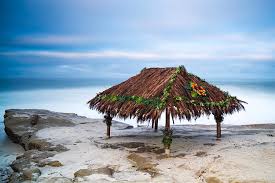Unless you are a surfer or a local, you might not know about La Jolla’s famous Surf Shack at Windansea Beach located below Neptune Place at the west end of Westbourne, Nautilus, and Bonair streets.
Besides its noteworthy surf, Windansea Beach showcases a palm frond-covered shack planted in the sand along the shore. It was designated as a historical landmark by the San Diego Historical Resources Board on May 27, 1998.According to historians and surfers, the shack was built in 1946 by local San Diego surfers Woody Ekstrom, Fred Kenyon, and Don Okey.
Throughout the 1940s, Windansea Beach was considered the ultimate place for surfing, as well as the formation of the Windansea Surf Club.Prior to the club’s formation, it has been said they visited the surf spot during the 1960s and founded the club so they could enter a surf contest in Malibu.
In its heyday, the areas were also a place for Polynesian luau beach parties during the 1940s and 1950s.
Nowadays
Today, Windansea Beach is still is home to the San Diego beach culture and is widely respected by the locals as a sacred place. However, well known as it may be, it has been able to keep a rather low profile. If you go, be aware there are limited parking spaces and no public facilities such as water fountains, restrooms or showers.
However, surfers still come from far and wide to this famous beach to ride the same surf that many famous surfers once.
La Jolla Historical Society Historian Carol Olten said the Surf Shack itself is unusual for the simple fact that “it has historical designation. I don’t know how many surf shacks around the world have such a designation, but ours does.”
She said what makes it even more special is that surfers Woody and Carl Ekstrom, as well as many old surfing families in and around La Jolla, are connected to the structure.
“There was also ‘Woody’ Parker Brown, who was kind of a mystic who came out from the East Coast and when he suddenly saw the waves, he became a world-class surfer,” she said. “Then he started building hang gliders and became a world-class hang glider and surfer.”
She added Woody and Carl Ekstrom were “well known throughout the surf world, and Woody is now in his 90s living in North County while Carl became world-known for his surfboard building.”
Olten, like many, said the Surf Shack does blow over periodically or a wave catches it and it must be rebuilt, but that’s fine by locals.
“I think if you talk to any surfers about it, they realize the Surf Shack has a great history and there is something charismatic about Windansea Beach. I also think you must be a surfer to really dig it.”
Olten recalled she used to lay on the beach to get a tan when she first moved to La Jolla in the mid-1960s.
“Back then the surf crowd was small but then ‘Gidget’ movies came around,” she said. “After that, there was a shift and surfing became big and even bigger. Then Tom Wolfe wrote his book [‘The Pump House Gang,’ 1968] and blew the culture out of proportion. Some surfers were upset and many were ticked off.”
Sacred shack
Long-time surfer Bird Huffman, 62, who is also the owner of Bird’s Surf Shed at 1091 W. Morena Blvd. in San Diego, said the Surf Shack is indeed sacred to surfers.
Huffman was born and raised in San Diego and said he has been “going to the La Jolla beaches since day one.”
“The Windansea Shack has always been in my life since I started surfing there 50 years ago,” he said. “It was one of many structures built along the California coast by the few true original surfers. Because it sits smack dab in front of one of California's most important surf breaks, [that] has always guaranteed its respect and popularity.
“While there have been encampments all over the place – San Onofre and Malibu – I think the Surf Shack at Windansea has more prestige,” Huffman continued. “The fact the Windansea Surf Club is tied to it also gives it its own notoriety throughout the world.”
Besides being a historical landmark, the area and the Surf Shack has served as a base for many events such as weddings, funerals, and memorial paddle outs, as well as daily use to hide from the shade and just relax, Huffman added.
Sustainability
Like Olten, Huffman said the Surf Shack has been ravaged by bad weather time and again over the decades but somehow it always gets rebuilt and/or repaired.
“True, although it has been knocked down and suffered some bad storms, it continues to be maintained by local surfers and members of the Windansea Historical Association and Windansea Surf Club,” Bird said.
He said when this happens, the Surf Shack gets torn down and then will be moved further back because of extremely high tides.
“Locals defend it sometimes by taking palm fronds off the wooden structure so there isn’t such a drastic impact when there's a storm,” he said.
Additionally, Huffman said beams have been replaced periodically but he isn’t certain if there is a solid piece of the original shack remaining.
“Even though it’s a fundamental structure, quite a few local La Jolla families have watched it over the years and have tried to keep it in place with chains, ropes, and watched so it doesn’t become condemned or torn down,” Huffman said.
He added there used to be “many great shacks up and down the coastline but as the 1960s and 1970s came so did liability, and they were torn down.”
“… But people here took a vested interested to get the Surf Shack as a landmark. They wanted to leave something in this town that was original and give a nod to the way it was and what it was like during a simpler time.”
As for how the original builders might feel today knowing their structure is alive and well, Huffman said: “Up until their passing, most of them would visit it regularly and I feel would enjoy their accomplishment. It's a generational thing so it is assured preservation and respect.”


